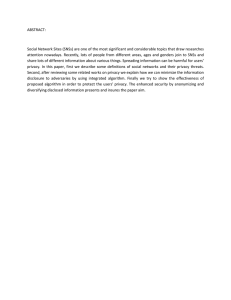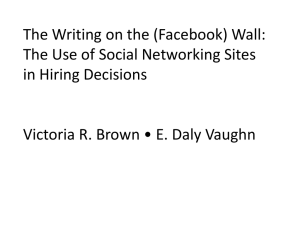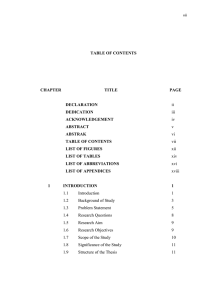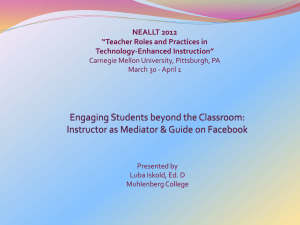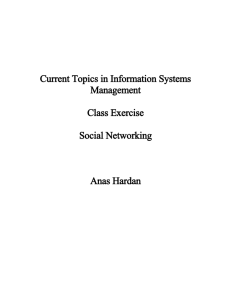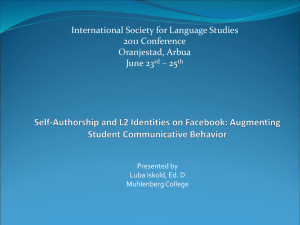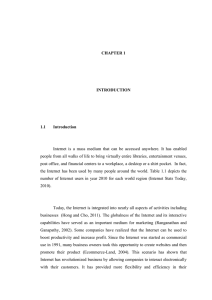SNS Impact on Teen Interpersonal Relationships: A Sociological Analysis
advertisement
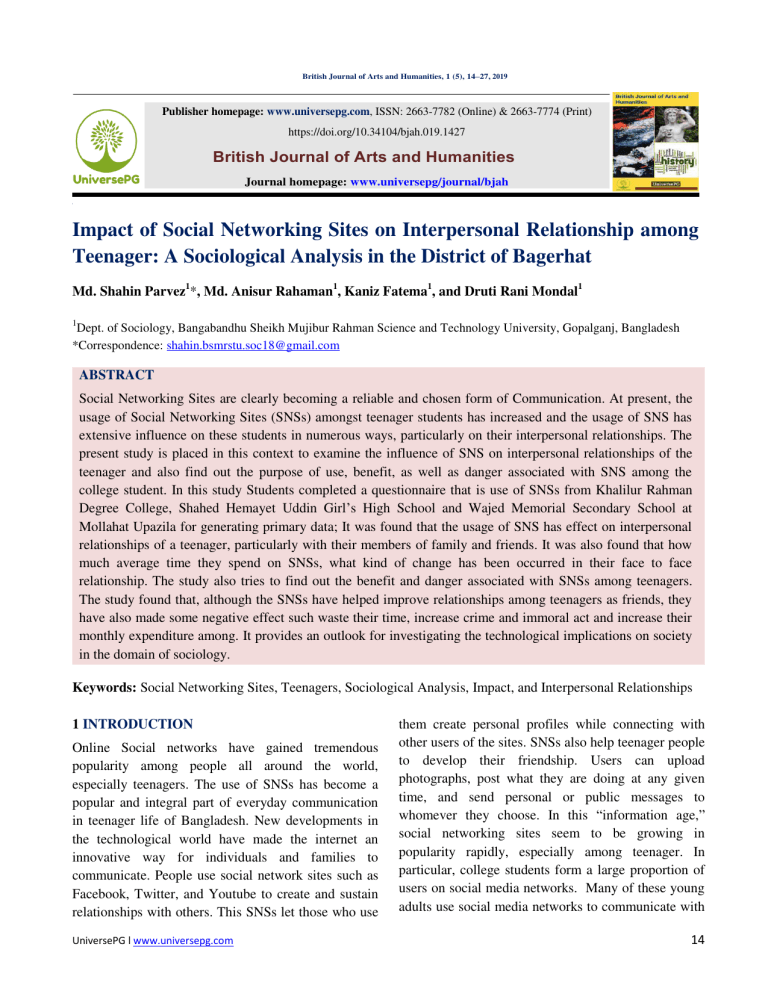
British Journal of Arts and Humanities, 1 (5), 14–27, 2019 Publisher homepage: www.universepg.com, ISSN: 2663-7782 (Online) & 2663-7774 (Print) https://doi.org/10.34104/bjah.019.1427 British Journal of Arts and Humanities Journal homepage: www.universepg/journal/bjah [[ Impact of Social Networking Sites on Interpersonal Relationship among Teenager: A Sociological Analysis in the District of Bagerhat Md. Shahin Parvez1*, Md. Anisur Rahaman1, Kaniz Fatema1, and Druti Rani Mondal1 1 Dept. of Sociology, Bangabandhu Sheikh Mujibur Rahman Science and Technology University, Gopalganj, Bangladesh *Correspondence: shahin.bsmrstu.soc18@gmail.com ABSTRACT Social Networking Sites are clearly becoming a reliable and chosen form of Communication. At present, the usage of Social Networking Sites (SNSs) amongst teenager students has increased and the usage of SNS has extensive influence on these students in numerous ways, particularly on their interpersonal relationships. The present study is placed in this context to examine the influence of SNS on interpersonal relationships of the teenager and also find out the purpose of use, benefit, as well as danger associated with SNS among the college student. In this study Students completed a questionnaire that is use of SNSs from Khalilur Rahman Degree College, Shahed Hemayet Uddin Girl’s High School and Wajed Memorial Secondary School at Mollahat Upazila for generating primary data; It was found that the usage of SNS has effect on interpersonal relationships of a teenager, particularly with their members of family and friends. It was also found that how much average time they spend on SNSs, what kind of change has been occurred in their face to face relationship. The study also tries to find out the benefit and danger associated with SNSs among teenagers. The study found that, although the SNSs have helped improve relationships among teenagers as friends, they have also made some negative effect such waste their time, increase crime and immoral act and increase their monthly expenditure among. It provides an outlook for investigating the technological implications on society in the domain of sociology. Keywords: Social Networking Sites, Teenagers, Sociological Analysis, Impact, and Interpersonal Relationships 1 INTRODUCTION Online Social networks have gained tremendous popularity among people all around the world, especially teenagers. The use of SNSs has become a popular and integral part of everyday communication in teenager life of Bangladesh. New developments in the technological world have made the internet an innovative way for individuals and families to communicate. People use social network sites such as Facebook, Twitter, and Youtube to create and sustain relationships with others. This SNSs let those who use UniversePG l www.universepg.com them create personal profiles while connecting with other users of the sites. SNSs also help teenager people to develop their friendship. Users can upload photographs, post what they are doing at any given time, and send personal or public messages to whomever they choose. In this “information age,” social networking sites seem to be growing in popularity rapidly, especially among teenager. In particular, college students form a large proportion of users on social media networks. Many of these young adults use social media networks to communicate with 14 Parvez et. al., / British Journal of Arts and Humanities, 1 (5), 14-27, 2019 family, friends, and even strangers. According to Zeng (2013), a good plan to promote marketing is by utilizing social media to sell tourism goods. Moreover, search engines have become another essential tool because there is too much information on the Internet (Xiang and Gretzel, 2010). Social networks play a major role in building, maintaining or even reviving relationships and improving teenagers learning skills. In this research we focused mainly on the impact of SNSs on teenager especially in college and school student and how SNSs change their relationship pattern. In most third world countries use of the internet has been made even more accessible by mobile phones. Today people are using the internet mostly to interact on social media, they chat, message, share photos and stay in touch with friends and relatives worldwide. SNSs such as Friendster, World, Face book and Myspace allow individuals to present themselves, articulate their social networks, and establish or maintain connections with others. SNSs allow users to share ideas, pictures, posts, activities, events, and interests with people in their network. Face book members can also join virtual groups based on common interests, see what classes they have in common, and learn each other’s' hobbies, interests, musical tastes, and romantic relationship status through the profiles (Ellison et al., 2007). Teens mostly use the Internet for entertainment and for communicating with friends and family. They have been popular since the year 2002 and have attracted and fascinated tens of millions of Internet users (Boyd and Ellison, 2007). The nature of relationships will be examined for the effect of SNSs on the quality and the pattern of the relationship. Youths use technology to keep in touch with friends, mediate romantic relationships, organize into social groups, support each other, and develop their own identities (Ito et al. 2010). The Usages of SNSs brought a lot of change among on interpersonal relationships teenagers and their family and friends. Social media refers to the means of interactions among people in which they create the share, exchange and comment contents among themselves in virtual communities and networks (Shahjahan A.T.M and Kutub Uddin Chisty, 2014). Social networking tools like Twitter, Facebook, Flickr, and Blogs have facilitated the creation and exchange of ideas so quickly and widely than the conventional media. Bangladesh Telecommunications Regulatory Commission (BTRC) statistics show that the country currently has around 70,000,000 mobile phone subscribers. Bangladesh is also feeling the heat of online SNSs (Thawhidul, 2008). Online social networking has become globally growing phenomena over the last decade (Nasrin Akter, 2014). It is a known fact that young adults and teenagers are the most avid users of SNSs which have a great impact on their lives. The most popular activities done by students and users on SNSs revolve around looking at profiles of one another, searching for someone here and there, updating one ‘s own profile, and eavesdropping. According to Vitak (2008), there are various reasons as to why individuals use SNSs. The main reason is for them to meet strangers and become friends. The majority of respondents of her research paper (57%) said that they were initially introduced to those “friends” through mutual friends, which increased the likelihood of such relationships developing into strong ties. Folorunso (2010) conducted a survey among students of the University of Agriculture, Abeokuta in Nigeria and tested the attributes of Diffusion of Innovations (DOI) theory towards usage pattern of SNSs. Bicen and Cavus (2010) evaluated the usage of SNSs among students in the department of computer education instructional technology and found which SNSs are the most preferred by students. Won Kim and Sang-Won Lee (2009) rightly pointed out that today the college students use numerous SNSs, to stay connected with their friends, discover new “friends” and to share users – created contents, such as photos, videos, blogs and etc. Tiffany et al. (2008) millions of contemporary young adults use social networking study, 92 undergraduates completed a diary-like measure each day for a week, reporting daily time use and responding to an activities checklist to assess their use of the popular SNS, Facebook. Geetanjali Naidu & Sunil Agrawal (2013) in today's scenario social media became a very useful tool in buying behavior decision making. It is influencing customer/consumer in a dynamic manner. According to Berlinger (2000) virtual life experiences can blind us the importance of 15 UniversePG l www.universepg.com Parvez et. al., / British Journal of Arts and Humanities, 1 (5), 14-27, 2019 human contact we need for our physical, psychological and social wellbeing. Kruat et al. (2002) found that frequent use of SNSs would result in a social circle declination. Mecheel (2010), identifies the impact of the social networking on social relations. Shim YoungSoo (2007) identifies the impact of the Internet on the face to face communication of teenagers. Al-Otaibi (2008) aimed to identify the impact of Facebook on the university’s students of Saudi Arabia. The prevalence of the use of Facebook among the universities students of Saudi Arabia amounted to 77%. The major objectives of the study are to know the purpose of usages of social networking site by the college students, to dig out the changes of interpersonal relationship pattern through social network site among teenagers, to determine benefits of using SNSs, and to identify the danger associated with SNSs. 1.1 Rational of the Study The study looks at the impact of SNSs on interpersonal relationships among teenagers, its findings will be relevant because they will inform parents, teachers, students and all the relevant stakeholders on the impact of SNSs on the interpersonal relations among teenagers. The result of this study will make the students who in this study are being referred to as teenagers, to be aware of how SNSs influence their interpersonal relations. It will also help their teachers by suggesting some ways in order for them to relate to student’s social activities especially with regards of using social networking sites. The parents will be helped to understand their children’s purpose to using social networking sites and for them to be aware of the influence of social networking sites that might affect their children. Finally, this study will help further studies of future researchers regarding the influence of social networking sites on the interpersonal relationship of students. 1.2 Conceptual Framework (a) Teenager - Teenager is a young person whose age falls within the range from thirteen through nineteen (13-19). (b) SNSs - The full meaning of SNSs is Social Networking Sites. (c) Social Networking Sites - Social networking site is a web site that is designed to help people communicate and share information, photographs, etc. with a group. (d) Social Media - Social Media refers to the means of interaction among people in which they create, share, and/or exchange information and ideas in virtual communities and networks. (e) Interpersonal Relationship - A bond between two or more people refers to an interpersonal relationship. An interpersonal relationship is a strong, deep or close association between two or more people that may range in duration from brief to enduring. 1.3 Limitations of the Study - This study is only limited to and within the reach of all those in the sample population who have access to the internet. It will also only cover students in boarding secondary schools because most of these students are from urban areas and they are familiar with SNSs. These limitations are due to the limited time schedule. 2 Theoretical Frameworks There are several theories that should be introduced in this paper for they are strongly related to the content which can help explain the users’ behaviors. The theories are Technology Determinism, Social Penetration, and Uses and Gratification. 2.1 Technology Determinism - Technological Determinism is the beliefs by Thorstein Veblen (2010) that technology determines social and cultural changes (history), and that it is the key governing force in society. Technological Determinism Theory explained how technology advances impacts every aspects of society including methods of communication. The five key beliefs of Technological Determinism pointed out by WaratKaruchit, 2013. As stated by Marshall McLuhan, the Canadian literary scholar during 1960s, it is the medium that shapes and controls the scale and form of human association and action (WaratKaruchit, 2013). He proclaimed that media is an extension of man, extending a man’s vision, hearing and touch through time and space. 2.2 Social Penetration - Social Penetration theory was made to describe the development of interpersonal relationships that refers to the interchange process of 16 UniversePG l www.universepg.com Parvez et. al., / British Journal of Arts and Humanities, 1 (5), 14-27, 2019 behaviors between two or more parties who are in the process of developing a relationship. Facebook, for example, users are able to set their privacy level (McCarthy, 2009). People are more likely to disclose more personal information on SNSs than they would in face to face communication because the level of control is higher (Ledbetter et al., 2011). 2.3 Uses and Gratifications - In order to understand the motivation and the purpose of Social Networking usage, Uses, and Gratifications Theory (UGT) was being examined. The Four basic needs of UGT: Information, Entertainment, Personal Identity, and Personal Relationship and Social Interaction. Since there are Facebook pages to subscribe, and it is practically online twenty-four hours a day, users receive information from their preferred sources i.e. news, fun facts, up-coming events, etc (WaratKaruchit, 2013). 2.4 Network Society - The Spanish sociologist Manuel Castells created one of the most ambitious macro theories of our time, which endeavors to explain and interpret power, economy, and social life in a world transformed by globalization and informatization. Through Castells, theory Researcher can understand that Information and communication Technologies changing the structure of our society and also change our communication pattern, relationship pattern. 3 METHODOLOGIES The Chapter covers the unit of the study such as the main method applied in the study, data collection process, sampling and data validation are discussed in this chapter. It comprises the theoretical analysis of the body of methods and principals associated with a branch of knowledge. 3.1 Method of the Study - This study was used both quantitative and qualitative data. The aim of using both methods that “bring together the different capability and non-overlapping weaknesses of quantitative methods with those of qualitative methods” (Creswell and Plano Clark, 2007; Johnson and Onwuegbuzie, 2004; Kelle, 2006). Using survey research method, both quantitative and qualitative data will be collected from teenagers who are studying in Wajed Memorial UniversePG l www.universepg.com Model School, Shahed Hemayet Girls High School and Khalilur College at Mollahat Upazila in Generally, we will use the Survey prepared Questionnaires. Uddin Secondary Rahaman Degree Bagerhat District. Method as well as 3.2 Study Area - The study area will include Mollahat Upazila in Bagerhat District. 3.3 Unit of Analysis - The unit of analysis is the major entity that is being analyzed in a study. It is the ‘what’ or who that is being studied. In social science research, typical units of analysis include individual, groups, social organization and social artifacts. Here we will discuss the SNSs and its impact on the interpersonal relationship among teenagers. 3.4 The Population of the Study - Now we are identifying the target population, the group of people that we want to draw a conclusion about once the research study is finished. Identifying the target population requires specifying the criteria that determine which individuals are included and which individuals are not included. 3.5 Sampling Procedure and Sample Size - Sampling technique was used for choosing a sub-group from the population to participate in the study. Probability sampling method has been utilized to develop a suitable sample size. With a view to choosing a representative a sample, simple random sampling method has been employed. So, the researcher conducted this research, especially purposive sampling. 3.6 Sources of Data - For the research purpose, we will use secondary data from the various journal, newspapers, conducted research as well as primary data from direct interview and survey method. 3.7 Study Instrument - Questionnaire was used as the main data collection instrument for this study. For collecting the necessary information, a semi-structured questionnaire with a series of the close-and openended question was used. 3.8 The Technique of Data Collection - The data collection technique for this study was a survey which is the most widely used data-gathering technique in Sociology. It is particularly strong when the answers 17 Parvez et. al., / British Journal of Arts and Humanities, 1 (5), 14-27, 2019 respondents give to questions measure variables. Instead of a face-to-Face survey, the self-administrated questionnaire was considered more convenient for this study. Questionnaire both structure and semi-structure, open-ended and close-ended question are used. 3.9 Techniques of Data Processing - Since the collected data in itself does not contain meaning, the act of data processing and analysis has the objectives of bringing meaning to the data and displays it to the reader. Firstly, the data has been edited and then has been coded and tabulated. At last all data were input into computer through software of Social Research SPSS. 3.10 Analysis and Interpretation of Data - Analysis of data is a process of inspecting, cleansing, transforming, and modeling data with the goal of discovering useful information, suggesting conclusion and supporting decision making. We used the mixed variety of data analysis. Some statistical techniques 4 RESULTS AND DISCUSSION 4.1 Socio-economic and Demographic Characteristics of the Respondents. Table 1: Age of the Respondents. Valid Frequency Percent 14 years 15 years 16 years 17 years 18 years Total 3 7 4 5 16 35 8.6 20.0 11.4 14.3 45.7 100.0 and procedure, charts such as pie chart, bar diagram, tables in terms of data analysis has been used. 3.11 Data Validation - Data collected in this research through the social survey is compared to the views given by the respondents. Moreover, relevant research findings on the impact of SNSs on the interpersonal relationship among teenager are also examined to find the relevance of the data gathered in the research. 3.12 Ethical Consideration - Ethical issues are very important for doing social research. The researcher has tried her level best to maintain the values, norms, and ethics of the research. In this research work, respondents’ rights to privacy and confidentiality have been kept secure. No attempts were made to force respondents to do or tell anything unwilling or to harm them. This Research shows the age categories of the respondents. An overwhelming majority of 45.7% was 18 years old while 8.6% were between 14 years old, 20% are 15 years, 11.4% are 16 years, and 14.3% are 17 years old, this indicates that all of the respondents belonged in the teenage years, with majority falling between mid and late teenager. Table 2: Gender of the Respondents. Valid Female Male Total Frequency 15 20 35 Percent 42.8 57.1 100.0 [[[ Fig 1: Various age levels of Respondents. Fig 2: Gender of the Respondents. 18 UniversePG l www.universepg.com Parvez et. al., / British Journal of Arts and Humanities, 1 (5), 14-27, 2019 4.2 Study of the Purpose of Usages SNSs Sites. Table 3: Respondents normally have account. Valid Twitter You tube Facebook Whats app Imo Total Frequency 2 7 23 1 2 35 Percent (%) 5.8 19.8 65.7 2.9 5.8 100.0 The respondents were asked the social networking sites they had accounts with. Findings show that 65.7% of the respondents said they had accounts on Facebook. 19.8% said they had an account in youtube, 5.8% said they had an account on Twitter, 2.9% said they had an account Whatsapp, 5.8% said they had an account on imo. The majority are used Facebook. Fig 3: Account on Social Networking Sites. Table 4: Respondents favorite levels of SNSs. Valid Facebook Facebook and Imo Facebook and whatsapp Facebook and You tube Imo You tube Total Frequency 23 2 1 2 2 5 35 Percent 65.7 5.8 2.7 5.8 5.7 14.3 100.00 Fig 4: Affect speak and writing style by SNSs. Fig 5: Respondents favorite level of SNSs. 19 UniversePG l www.universepg.com Parvez et. al., / British Journal of Arts and Humanities, 1 (5), 14-27, 2019 The respondents were further asked about their favorite social networking site. The study finds out that 65.7% of the respondents cited Face book as their favorite social networking site, 5.8% Cited Facebook and Imo, 2.7% mentioned Facebook and Whatsapp, 5.8% mentioned Facebook and Youtube, and 5.7% mentioned only YouTube and 14.3% of the respondents cited 14.3%. This shows that Face book is the most popular among teenagers among the listed social networking sites. Table 5: Respondents gets access to their favorite Social Networking Sites. Valid Laptop Android Mobile Total Frequency 4 31 35 Percent (%) 11.4 88.6 100.0 Fig 6: Average time spend in online every day. Fig 7: Different purposes of using SNSs sites by Respondents. The study finds out how the respondents got access to their favorite social networking site. Most of the respondents 88.6% use Android mobile phones rather than they use Laptop. Table 6: Purpose of Using SNSs. Valid Study Recreation Chatting Downloading video, music and others Total Frequency Percent (%) 2 5.7 9 25.7 17 48.6 7 20.0 35 100.0 Cumulative Percent 5.7 31.4 80.0 100.0 Fig 8: Respondents view about the importance of SNSs. 20 UniversePG l www.universepg.com Parvez et. al., / British Journal of Arts and Humanities, 1 (5), 14-27, 2019 Researchers have found that teenagers find creative ways to gain access to new technologies, participate in various online communities that help them in many ways. Only 5.7% respondents said that they use SNSs for study, 25.5% are used for recreation, most of them use for chatting with friends cited 48.6%, (20.0%) are used for downloading video, music and other purpose. Valid Frequency Percent Valid percent Yes 28 80.0 80.0 No 7 20.0 20.0 100.0 100.0 Total 35 Cumulative percent 80.0 100.0 The study went to find out those SNSs affect speak and writing the style of the respondents. Here 80% of respondents said that SNSs affect or change their writing and speaking style on the other hand 20% said that SNSs don’t affect them. 4.3 SNSs and Interpersonal Relationship. Table 8: Respondents like most doing in online. Valid Chatting Chatting and downloading Chatting and watching Video Chatting, Watching video Gaming and chatting News and chatting News and class lecture download Reading News Try to get Educational Information Video chat Video Download Watching body building motivational video Watching movie Watching news and video Watching video Watching video and drama Total Table 7: SNSs affect speak or writing of the Respondents: Frequency 16 1 1 1 1 1 1 3 1 1 1 1 1 1 3 1 35 Percent 45.7 2.9 2.9 2.9 2.9 2.9 2.9 8.6 2.9 2.9 2.9 2.9 2.9 2.9 8.6 2.9 100.0 Cumulative Percent 45.7 48.6 51.4 54.3 57.1 60.0 62.9 71.4 74.3 77.1 80.0 82.9 85.7 88.6 97.1 100.0 The Research illustrates that the majority of teenagers (45.7%) are like chatting online. Respondents also like downloading video, watching movie and drama, reading News and many other activities through SNSs sites. Table 9: Average time spends in online every day. Valid 2 Hours 3 Hours 4 Hours 5 Hours Total Frequency 19 5 5 6 35 Percent (%) 54.3 14.3 14.3 17.1 100.0 Fig 9: Respondents average keeps in touch with friends online than offline. 21 UniversePG l www.universepg.com Parvez et. al., / British Journal of Arts and Humanities, 1 (5), 14-27, 2019 The respondent was asked how much time they spend on social networking sites. The study shows that (54.3%) are spending time in online 2 hours, (14.3%) 3 and 4 hours, (17.1%) 5 hours. Table 10: SNSs are important, respondent view. Valid Frequency Yes No total 33 2 35 Percent (%) 94.3 5.7 100.0 Cumulative Percent 94.3 100.0 Majority of the Respondents viewed that social networking sites are important for many purposes. Table 11: SNSs affect face to face relationship. Valid Yes No Total Frequency Percent (%) 17 48.6 18 51.4 35 100.0 Cumulative Percent 48.6 100.0 Majority of the respondents (51.4%) said that SNSs does not affect Face to Face relationship and 48.6% respondents said SNSs affect their relationship and most of them are given the positive answer that SNSs are helping to communicate with friends and family member more than before. It also helps to strengthen relation with friends and family member. Fig 10: Affect relationship with friends. Fig 12: Changes of the relationship with friends. Fig 11: Relationship status with the parents. Fig 13: Changing categories of face to face relationship. 22 UniversePG l www.universepg.com Parvez et. al., / British Journal of Arts and Humanities, 1 (5), 14-27, 2019 Table 12: Various kind of changes in Face to Face relationship by using SNSs. Valid Connect more time family and friend Decrease Distance Frequency 18 1 Percent (%) 51.5 2.9 Develop Develop and Strong Development of friendship Can’t give time friends Improve relationship Improve and strengthen relation Reduce distance Spend less time Spend more time and strong bonding Spend more time on SNSs so decrease relation with nearer Strong bonding with Friends Total 1 1 3 1 4 1 1 1 1 1 1 35 2.9 2.9 8.1 2.9 11.4 2.9 2.9 2.9 2.9 2.9 2.9 100.0 Table 13: SNSs are easier to keep touch with friends online than offline. Valid Frequency Strongly Agree Agree Disagree Strongly Disagree Total 13 Percent (%) 37.1 Cumulative Percent 37.1 The study digs out that 37.1% strongly agreed and 54.3% agreed they found it easier to keep in touch with friends online than offline. Only 8.6% is said that it is not easy to keep in touch with friends online. Table 14: SNSs affect the relationship with friends. 19 3 0 54.3 8.6 0 35 100.0 91.4 100.0 Valid Frequency Yes No Total 27 8 35 Percent (%) 77.1 22.9 100.0 Cumulative Percent 77.1 100.0 Majority of the respondents (77.1%) said that SNSs affect their relationship with friends and 22.9% said that SNSs don’t affect their relationship. Fig 14: Easier to express an opinion through SNSs. Fig 15: Average decrease the distance by using SNSs. 23 UniversePG l www.universepg.com Parvez et. al., / British Journal of Arts and Humanities, 1 (5), 14-27, 2019 Table 15: Change the relationship with friends. Valid Strained Improved No Effects Frequency 1 30 4 Percent (%) 2.9 85.7 11.4 Social Networking Sites are an easy way to decrease distance and 85.7% respondents agree with this, 14.3% are said SNSs are not decrease distance it increases distance. The research shows that SNSs improved the relationship with friends and 85.7% agree with the statement only 2.9% are stand opposite it. Table 16: Change the Relationship with parents. Valid Frequency Percent (%) Strained Improved No effects Total 3 6 26 35 8.6 17.1 74.3 100.0 Fig 16: SNSs strengthening of interpersonal relationship. Majority of the respondents (74.3%) said that relationships with parents are the same as before when they don’t use SNSs and 17.1% said their relation is improved and 8.6% mentioned that their relationship with parents is strained day by day. 4.5 The Benefit of using Social Networking Sites. Table 17: Easier to express an opinion through SNSs. Valid Frequency Percent (%) Yes 35 100.0 No 0 0 100.0 Total 35 Cumulative Percent 100.0 Fig 17: SNSs influences cognitive development. All the respondents said that SNSs are an easy way to express the opinion of any comments. Table 18: SNSs decreased the distance. Valid Frequency Yes No Total 30 5 35 Percent (%) 85.7 14.3 100.0 Cumulative Percent 85.7 100.0 Table 19: SNSs Strengthen interpersonal Relationship. Valid Yes No Total Frequency 30 5 35 Percent (%) 85.7 14.3 100.0 Fig 18: Respondents addicted with the SNSs. 24 UniversePG l www.universepg.com Parvez et. al., / British Journal of Arts and Humanities, 1 (5), 14-27, 2019 SNSs are a benefit because it also helps to strengthen interpersonal relationship and 85.5% mention it and 14.3% disagree with it. Table 20: Status of the cognitive development. Valid Yes No Total Frequency 9 26 35 Percent (%) 25.7 74.3 100 Most of the respondents (74.3%) mentioned that they normally use SNSs and (25.7%) are addicted to it. Social Networking Sites help to the respondents to influence their cognitive development it includes new thinking and all the respondents mentioned it. Fig 20: Nature of using of SNSs. 4.6 The Danger associated with SNSs. Table 21: Addicted with the use of SNSs. Valid Frequency Yes No Total 28 7 35 Percent (%) 80.0 20.0 100.0 Cumulative Frequency 80.0 100.0 Table 22: Status of the crime and immoral activities. Valid Highly Secured Lack of Privacy Total Frequency 12 23 35 Percent (%) 34.3 65.7 100.0 Fig 19: Increase the crime and immoral activities. Fig 21: SNSs waste the valuable time. Fig 22: Increase of the monthly expenditure by SNSs. Above 80.0% respondents said SNS increase crime and immoral act and 20.0% don’t mention it. 25 UniversePG l www.universepg.com Parvez et. al., / British Journal of Arts and Humanities, 1 (5), 14-27, 2019 Table 23: Nature of the using the SNSs. Valid Frequency Yes No Total 35 0 35 Percent (%) 100.0 0 100.0 Cumulative Percent 100.0 100.0 SNSs are highly secured 65.7% said that and 34.3% said SNSs has lack of privacy. Table 24: SNSs waste valuable time from life. Valid Yes No Total Frequency 27 8 35 Percent (%) 77.1 22.9 100.0 5 CONCLUSIONS The study set to examine that SNSs have created a phenomenon over the past decade. Facebook and Youtube have emerged as the most popular websites and have continued to grow in popularity. These websites create new ways of communication and set a new way of relationships with friends and family and also influence an individual’s self-concept. SNSs also offer new and innovative ways to communicate with other individuals in a quick manner. Computermediated communication provides individuals with easier and faster ways of communication. In addition, individuals are using social media websites at increasing rates and visiting them quite frequently. This study makes an important contribution to understanding college and school student’s use of SNSs and its effect on communication and their interpersonal relationships. SNSs had various impacts on the interpersonal relationships of the teenagers both online and offline. For instance, some of them would rather chat with an online friend than stage a face to face talk, this is because face to face may inhibit the teenagers from expressing themselves openly especially to members of the opposite sex. The study also concludes that, although the SNSs have helped improve relationships among close teenagers as friends. The research showed that teenagers have become addicted to SNSs. The usage of SNS brought lots of changes in interpersonal relationships between these students and members of the family and it also SNSs waste time of the respondent and 77.1% are mentioned it and 22.9% are standing opposite the statement. Table 25: Increase the monthly expenditure. Valid Yes No Total Frequency 31 4 35 Percent 88.6 11.4 100.0 Most of the respondents use SNSs through buy internet package that increases their expenditure, 88.6% are mentioned it and 11.4% their expenditure is not changed. helped students to have more communication with their family members. To build and maintain a relationship, it is a process of communicating and the level of revelation of personal thoughts and feelings. Bad communication is one of the major factors that harm interpersonal relationships. 6 ACKNOWLEDGEMENTS This research was supported with proper guidance in the Dept. of Sociology, Bangabandhu Sheikh Mujibur Rahman Science and Technology University, Gopalganj, Bangladesh. Heartiest thanks to the coauthors for helping us to conduct the successful research work. 7 CONFLICTS OF INTEREST The author (s) declared no potential conflicts of the interest with respect to the research. 8 REFERENCES 1. Al-Otaibi J. (2008). The impact of Facebook on Saudi university students (Unpublished master’s thesis). Faculty of Arts, King Saud University, Riyadh, Saudi Arabia. 2. Berlinger M. R. (2000). Internet and alienation. The New York Times. 3. Bicen Huseyin and Cavus Nadire (2010). “The Most Preferred Social Network Sites by Students” Procedia Social and Behavioral Sciences, 2, 5864-5869. 26 UniversePG l www.universepg.com Parvez et. al., / British Journal of Arts and Humanities, 1 (5), 14-27, 2019 4. Boyd D. & Ellison N. (2008). Social network sites: Definition, history, and scholarship. J. of Computer-Mediated Communication, 13, 210230. Doi:10.1111/j.1083-6101.2007.00393 5. Creswell W. John, Plano Clark, and Vicki L. (2007). Designing and conducting mixed methods research. Thousand Oaks, CA: Sage publication. 6. Ellison N. B., Steinfield C., & Lampe C. (2007). The benefits of Facebook "friends:" Social capital and college students' use of online social network sites. J. of ComputerMediated Communication, 12 (4), article 1. 7. Folorunso Olusegun (2010). “Diffusion of Innovation in Social Networking Site among University Students”. International J. of Computer Science and Security, 4 (3), 361372. 8. Geetanjali Naidu & Sunil Agrawal (2013). A Study on Impact of Social Media in Buying Behavior of Consumer/Customer with Special Reference to Raipur, J. of Harmonized Research in Applied Sciences, 1 (3), 98-101. 9. Ito M., Baumer Bittanti S. (2009). Hanging out, messing around, and seeking out: Kids living and learning with new media. Cambridge, MA: MIT Press 10. Johnson, Onwuegbuzie and Fox T. MacArthur (2009). Foundation Series on Digital Media and Learning. Cambridge, MA: MIT Press. 11. Kraut R., Kiesler S. (2002). Internet paradox revisited. J. of Social Issues, 58 (1), 49–74. 12. Ledbetter (2011). Attitudes toward online social connection and self-disclosure as predictors of Facebook communication and relational closeness. Research, 38 (1), 27-53. 13. McCarthy A. (2009). Social penetration theory, social networking, and Facebook. 14. Mecheel V. (2010). Facebook and the invasion of technological communities. NY: New York. 15. Nasrin Akter (2012). ‘Social Networking and the Youth’, Master’s thesis, Department of Sociology, University of Dhaka, Bangladesh. 16. Shahjahan Chisty and Kutub Uddin Chisty (2014). ‘‘World Academy of Science, Engineering and Technology”. International J. of Social, Behavioral, Educational, Economic, Business, and Industrial Engineering, 8 (6), 11-22. 17. Shim Young S. (2007). The impact of the Internet on teenagers’ face-to-face communication. Global Media J., 6 (10), e2237. 18. Thawhidul Kabir (2008). ‘Exploitation of Social Networking Sites and Its impact on students Academic Results’’ Bangladesh University of Business and technology. 19. Thorstein Veblen (2010). Mom just Facebooked me and dad knows how to text. The Elon J. of Undergraduate Research in communications, 1, 5-16. 20. Tiffany (2009). College students' social networking experiences on Facebook, J. of Applied Developmental Psychology, 30, 227238. 21. Vitak (2008). “Facebook Friends: How Online identities Impact Offline Relations”. 22. WaratKaruchit (2013). Media affects theories. Communication Theories and Innovation Communication. Bangkok: National Institute of Development Administration. 23. Won, Kim, and Sang-WonLee. (2009). “On Social Websites”. Information Systems. World Academy of Science, Engineering and Technology. 24. Xiang Z. & Gretzel U. (2010). Role of Social Media in Online Travel Information Search, Tourism Management, 31 (2), 179-188. 25. Zeng B. (2013). Social Media in Tourism, J. of Tourism and Hospitality, 2, 1-2, Doi:10.4172/2167-0269.1000e1 Citation: Parvez MS, Rahaman MA, Fatema K, and Mondal DR. (2019). Impact of Social Networking Sites on Interpersonal Relationship among Teenager: A Sociological Analysis in the District of Bagerhat. British J. of Arts and Humanities, 1 (5), 14-27. https://doi.org/10.34104/bjah.019.1427 27 UniversePG l www.universepg.com
